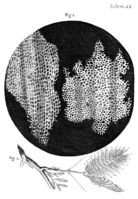
Photo from wikipedia
Anionic lipid membrane electrostatic potential and solution pH can influence cationic peptide adsorption to these bilayers, especially those containing simultaneously acid and basic residues. Here, we investigate the effects of… Click to show full abstract
Anionic lipid membrane electrostatic potential and solution pH can influence cationic peptide adsorption to these bilayers, especially those containing simultaneously acid and basic residues. Here, we investigate the effects of the pH solution on MP1 (IDWKKLLDAAKQIL-NH2) adsorption to anionic (7POPC:3POPG) lipid vesicles in comparison to its analog H-MP1, with histidines substituting lysines. We used the association of adsorption isotherms and constant pH molecular dynamic simulations (CpHMD) to explore the effects of membrane potential and pH on peptides’ adsorption on this lipid membrane. We analyzed the fluorescence and zeta potential adsorption isotherms using the Gouy–Chapman theory. In CpHMD simulations for the peptides in solution and adsorbed on the lipid bilayer, we used the conformations obtained by conventional MD simulations at a μs timescale. Non-equilibrium Monte Carlo simulations provided the protonation states of acidic and basic residues. CpHMD showed average pKa shifts of two to three units, resulting in a higher net charge for the analog than for MP1, strongly modulating the peptide adsorption. The fractions of the protonation of acidic and basic residues and the peptides’ net charges obtained from the analysis of the adsorption isotherms were in reasonable agreement with those from CpHMD. MP1 adsorption was almost insensitive to solution pH. H-MP1 was much more sensitive to partitioning, at acidic pH, with an affinity ten times higher than in neutral ones.
Journal Title: Membranes
Year Published: 2021
Link to full text (if available)
Share on Social Media: Sign Up to like & get
recommendations!